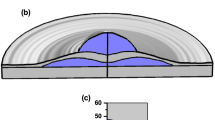Abstract
In this paper we computationally examine the magnetization and the magnetic susceptibility for vertically coupled quantum rings (VCQRs) under applied magnetic fields. The theoretical model of VCQRs considers a three-dimensional (3D) effective one-electronic-band Hamiltonian with the position- and energy-dependent effective mass, the finite hard-wall confinement potential, and the Ben Daniel-Duke boundary condition. The nonlinear iterative method is applied to solve the problem in the structure of VCQRs. For the structure formed with nanoscale disk-shaped InAs/GaAs quantum rings, the the tunable states of structure as well as the electron transition energy is dominated by the radius of ring (R) and the inter-distance (d) between quantum rings. The electron energy oscillates non-periodically among the lowest electron states as a function of external magnetic fields due to the penetration of magnetic fields into the inter-regions of VCQRs. The magnetization of VCQRs at zero temperature is non-periodical oscillation and the period of jump is governed by R. Therefore, the differential susceptibility of VCQRs has delta-like paramagnetic peaks. When d is increased, the peak is decreased which is contrary to conventional mesoscopic arguments. Our investigation is constructive for studying the magneto-optical phenomena of the nanoscale semiconductor artificial molecules.
Similar content being viewed by others
References
H. Akinaga et al.,“Semiconductor spintronics,” IEEE Transactions on Nanotechnology,1, 19 (2002).
A. Fuhrer et al.,1“Energy spectra of quantum rings,” Nature,413, 822 (2001).
R. Blossey et al.,“Wetting droplet instability and quantum ring formation,” Physical Review E,65, 021603 (2002).
A. Fuhrer et al., “Energy spectra of quantum rings,” Microelectronic Engineering,63, 47 (2002).
J. Planelles et al., “Energy structure of quantum rings in a magnetic field,” Physical Review B,65, 033306 (2002).
Y. Li et al., “Numerical Calculation of Electronic Structure for Three-Dimensional Nanoscale Semiconductor Quantum Dots and Rings,” Journal of Computational Electronics,2, 49 (2003).
M. Korkusinski et al., “Entangled states of electron-hole complex in a single InAs/GaAs coupled quantum dot molecule,” Physica E,13, 610 (2002).
T. Ota et al., “Transport properties of a single pair of coupled self-assembled InAs quantum dots,” Physica E,19, 210 (2003).
X. Hu et al., “Hilbert-space structure of a solid-state quantum computer: Two-electron states of a double-quantum-dot artificial molecule,” Physical Review A,61, 062301 (2000).
P. Yu et al., “Optical anisotropy in vertically coupled quantum dots,” Physical Review B,60, 16680 (1999).
Y. Tokura et al., “Single-electron tunnelling in two vertically coupled quantum dots,” Journal of Physics: Condensed Matter,11, 6023 (1999).
W. Xie et al.,“Ground-state transitions of coupled quantum dots in magnetic fields,” Physics Letters A,245, 297 (1998).
R. Heitz et al.,“Excited states and energy relaxation in stacked InAs/GaAs quantum dots,” Physical Review B,57, 9050 (1998).
B. Partoens et al.,“Classical Double-Layer Atoms: Artificial Molecules,” Physical Review Letters,79, 3990 (1997).
Y. Li et al.,“Electron Transition Energy for Vertically Coupled InAs/GaAs Semiconductor Quantum Dots and Rings,” Japanese Journal of Applied Physics,43, 2104 (2004).
Y. Li et al.,“Calculation of induced electron states in three-dimensional semiconductor artificial molecules,”Computer Physics Communications,147, 209 (2002).
G. Sek et al., “Photoreflectance spectroscopy of vertically coupled InGaAs/GaAs double quantum dots,”Solid State Communications,117, 401 (2001).
Author information
Authors and Affiliations
Corresponding author
Rights and permissions
About this article
Cite this article
Li, Y. Magnetization and Magnetic Susceptibility in Nanoscale Vertically Coupled Semiconductor Quantum Rings. J Comput Electron 4, 135–138 (2005). https://doi.org/10.1007/s10825-005-7124-7
Issue Date:
DOI: https://doi.org/10.1007/s10825-005-7124-7




